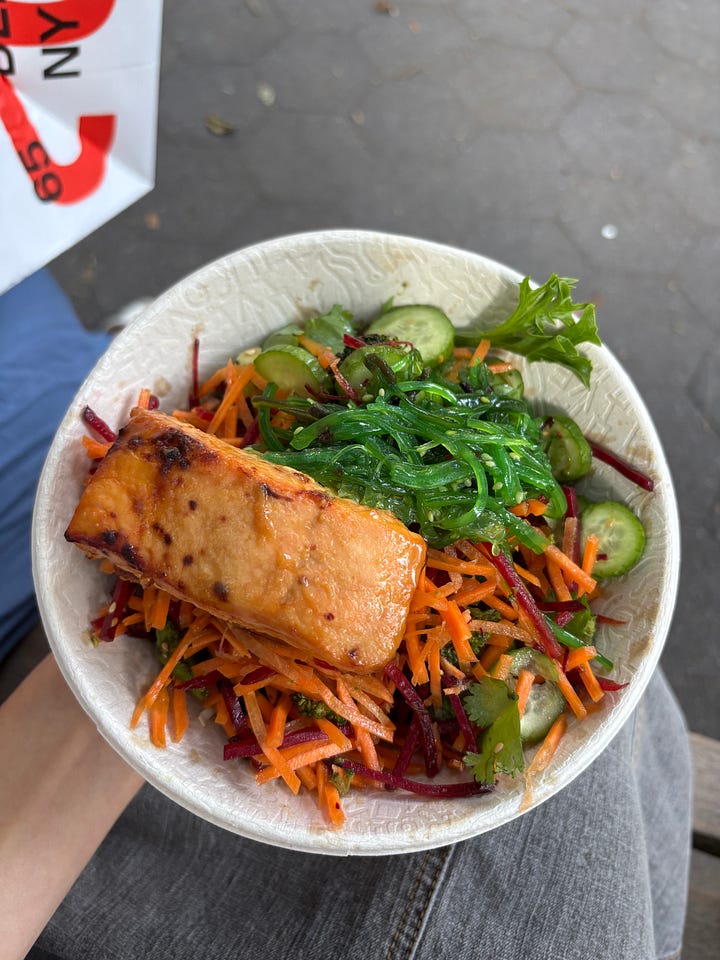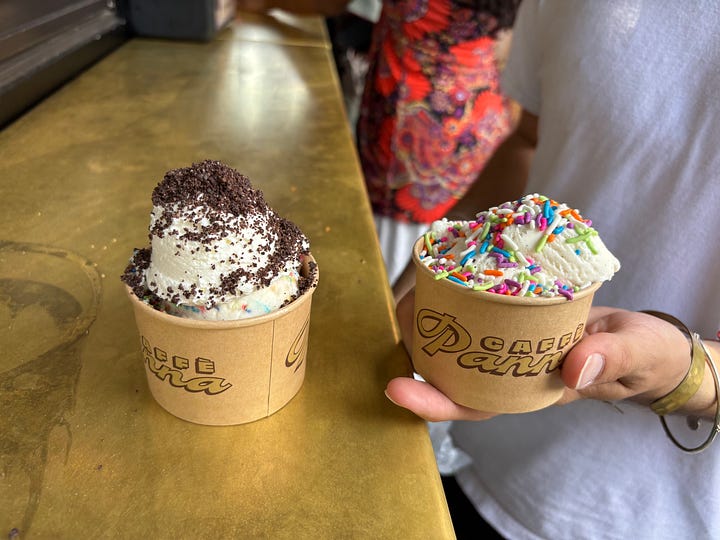I HATE WAITING ON LINE.
So why do I keep doing it?
In June, I got an Instagram ad for a Tank Air pop up in NYC. My friend and I decided to go on the first day it opened. As I walked up Bowery, I could see the front of the line, but I wasn’t surprised by its existence. She was coming from the opposite direction, and called me. Oh my god Arden, you have no idea how insane it is. The line slithered down the avenue and around the corner.
I studied the girls in line. Some were chatting, others read books, most were on their phones. I recognized a friend of a friend I only knew from Instagram. We decided to abandon our original mission—I wanted to check out the Dossier store opening too. It was on the other side of the block. To my horror, the line was just as long. It was 2pm on a Friday.
As we walked out of Soho, I thought myself enlightened by choosing not to participate in the mania. Don’t these people know that you can order the tank tops online? It felt like a hundred degrees in unrelenting humidity, and I couldn’t think of anything worse than waiting outside for hours, running my fingers across polyester fabric, waiting again for the dressing room, debating spending $80 on one top, and walking out empty handed. Or maybe I would have been inclined to make a purchase to make what I endured feel worth it.
The whole experience was baffling and upsetting. I say I hate lines, but I often subject myself to them. I’ve spent afternoons on sidewalks as a GA ticket holder to be as close as possible to the stage (often after joining digital Ticketmaster queues and accepting my place as 11,987th in line.)
I’ve waited two hours for a burger and an obscenely elaborate milkshake.
I’ve waited with high schoolers to get into the Brandy Melville on Broadway.
 Tiktok failed to load.
Tiktok failed to load.Enable 3rd party cookies or use another browser
In college, I waited in line every single day for dining halls and bathrooms and covid testing sites and frat parties and overpriced coffee.
Last week, another friend and I went to ThisBowl after talking about it for a year. There was no line at the NoMad location. We agreed that bowls were nothing special—we probably wouldn’t go again. Afterward, I proposed getting ice cream from Caffè Panna. We joined the line that was already wrapped around the block. I HATE LINES! I said. She laughed because whenever we hang out, we always find ourselves in one. I spent the evening wondering…AM I A SHEEP?


Why we wait: a brief history of lines.
In 1837, Thomas Carlyle wrote about the first-recorded single file lines in Paris in his book The French Revolution. During a period of famine, queues (Old French for “tails”) of peasants formed around bakeries. To stand in line meant to uphold the French Revolution’s ideals of liberty, equality, and fraternity—everyone waited their turn.
By the 20th century, the British had coopted the line. In a 1944 essay, George Orwell remarked on Brits’ “willingness to form queues” while waiting for wartime rations. The joke goes that if a British person sees a line, they will join it.
Lines were once a visible consequence for limiting the free market—they symbolized scarcity and inefficiency in times of heavy regulation. Then they became cornerstones of our daily lives. I can’t imagine a world without lines for grocery store checkouts or TSA security. Somewhere along the way, a third wave appeared. Waiting in line became a sport rather than a necessity.
The psychology of waiting in line.
I read “The Psychology of Waiting Lines” by David Maister to try and unravel my complicated feelings around line-waiting. Maister’s 2005 paper offers advice to those interested in reducing the negative impact long wait times have on customer experiences. He proposes exploiting the psychology of waiting lines, which rely on the following propositions:
Unoccupied time feels longer than occupied time. Some restaurants hand me a copy of the menu while I’m still standing in line.
People want to get started. Upon arriving at an urgent care, a nurse may greet me to take down my name and symptoms, no matter how long I might wait for proper treatment.
Anxiety makes waits seem longer. In airport security, I often worry that I have chosen the “wrong line.”
Uncertain waits are longer than known, finite waits. I feel calmer knowing exactly when the Subway is going to arrive, even if it’s 19 minutes away.
Unexplained waits are longer than explained waits. If it’s snowing, I expect that it will take more time to hail a taxi. If it’s sunny, I am confused.
Unfair waits are longer than equitable waits. If someone cuts me in line, I turn into a demon.
Solo waits feel longer than group waits. It helps to have someone to commiserate with/distract me.
Maister’s final idea is the most relevant to the hype-induced lines I’m most concerned with.
The more valuable the service, the longer the customer will wait.
Maister urges businesses to employ tactics to make waits seem shorter, more efficient, and as pleasant as possible. But twenty years later, instead of reducing real or perceived wait times, businesses are reveling in the lines outside of their doors. They record time lapse videos and post them on social media like a badge of honor. They limit indoor capacity so the line outside appears longer. A snaking line down Bowery signals a high value, high demand product. And the signal is often more important than the object it describes.
In my own moment of panic at Caffè Panna, I started to conjure my own theory of line-waiting, adapted for the age of TikTok and the shortest trend cycles to have ever existed.
There are four types of lines. Necessity, Guaranteed Consumption, Potential Consumption, and Experience. My willingness to wait depends on what kind of line it is, along with factors of length, speed of progression, hype (unfortunate, but true), weather, and my expected value.
Necessity. They suck, but there’s nothing you can do. Put in your headphones and try to dissociate.
Guaranteed Consumption. You know exactly what awaits. I knew Caffè Panna ice cream was good, and I was willing to wait 20 minutes to taste it again.
Potential Consumption. These lines are the most dangerous, and most often manifest in front of retail stores. Strangely, the friction actually heightens my likelihood of buying something.
Experience. I no longer wait to see Kusama’s Infinity Rooms at museums because I’ve been inside enough of them. If I am not a mega fan, I don’t mind being at the back of a concert venue.
Lines are identity signalers. Are you the kind of person who waits in the Supreme line, the Radio Bakery line, or the Jenna Lyons closet sale line? The New York Times wrote about the Supreme store lines in 2017. Highsnobiety editor Jeff Carvalho said “These kids don’t come to go into the store, they want to be in the line. The line is the new community.”
Lines are used as a proxy for the quality of a product or experience. On occasion, it is correct. In Berlin, when we joined the line for a schnitzel truck on the canal, and it was the best, crispiest version I have ever tried. More often, there is a mismatch.
After eating at ThisBowl and being severely disappointed, I said to my friend that I would have been infuriated if we’d had to wait for our $20 salmon bowls topped with raw vegetables. But wasn’t the fact of the line what incentivized us to go in the first place? Maybe if we had suffered in the NoMad humidity for thirty minutes, the house-made sodas would have been revitalizing, the miso-flavored Asian-inspired slop rendered the best thing in the world.
Lines create meaning in a world where everything is in abundance. They signal which items, foods, and experiences are worth waiting for. They delay satisfaction, and in doing so, heighten it. Even if it’s only an illusion.
Thank you for reading! What would you wait hours in line for?







oh my god i love this post so much...the history, the psychology, u are such a superstar
time lapse sequences tend to be very trendy in all forms of visual media